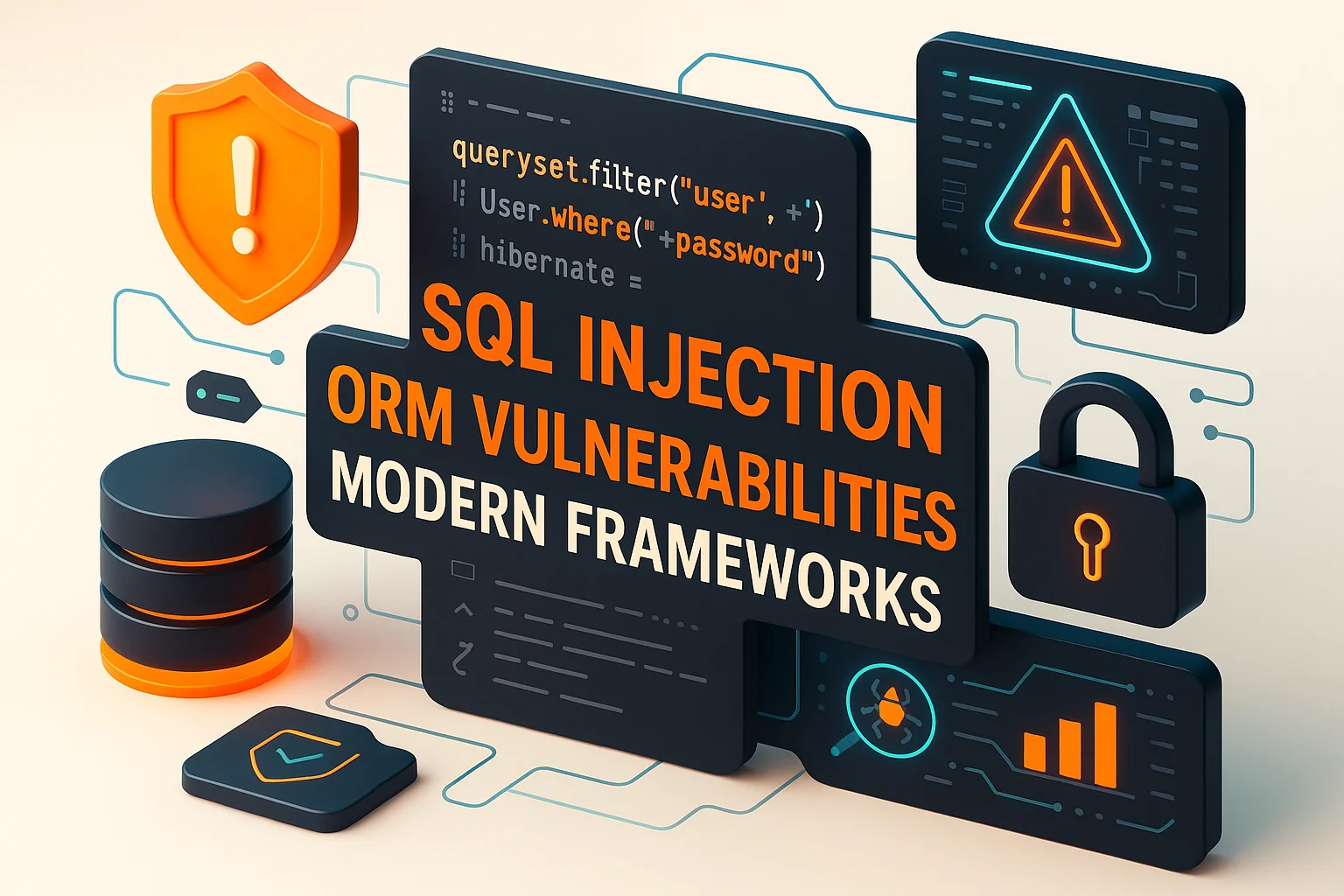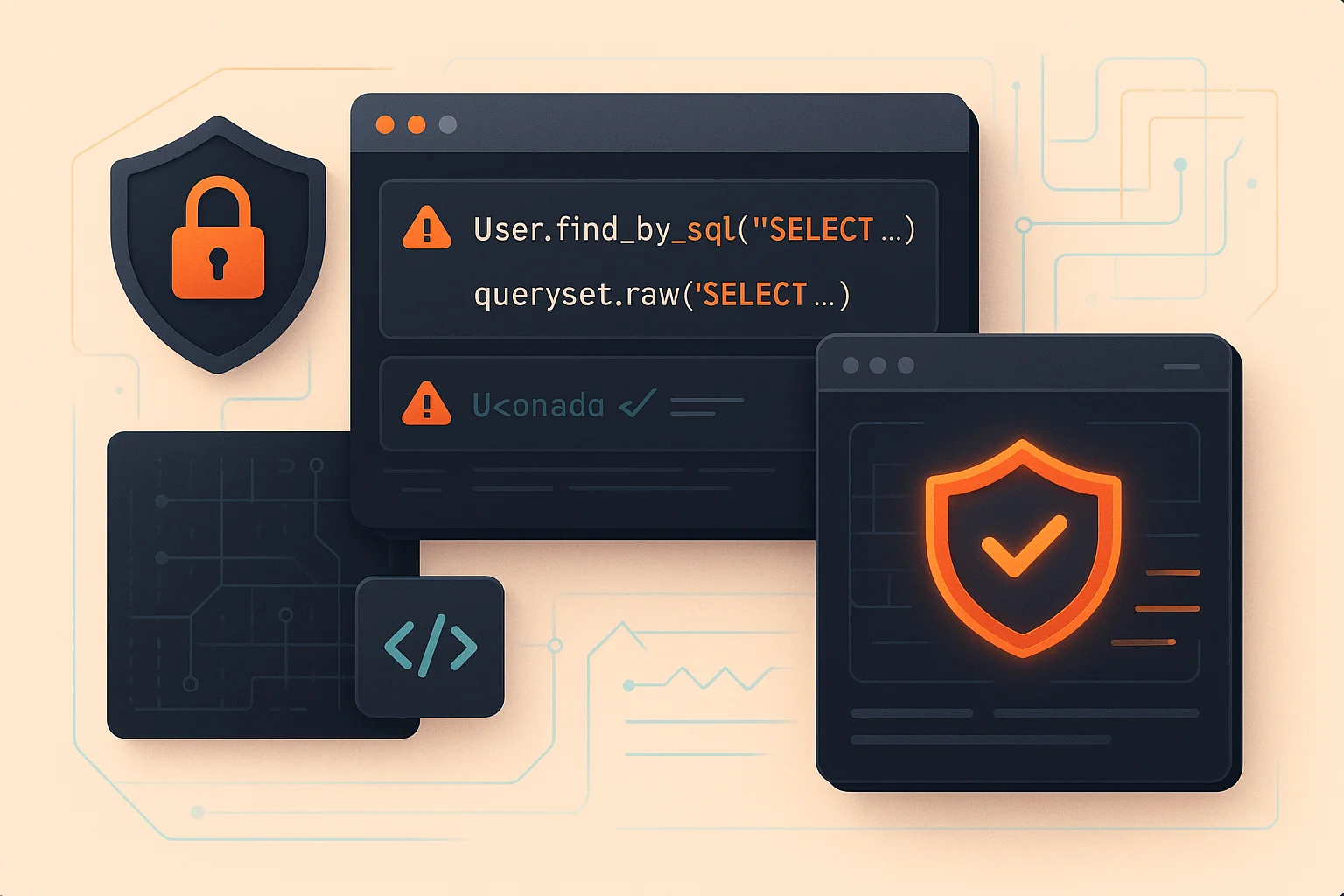SQL Injection in ORMs 2025: Why Modern Frameworks Still Aren't Safe

Object-Relational Mapping (ORM) frameworks promise to eliminate SQL injection vulnerabilities by abstracting database interactions. Yet in 2025, SQL injection remains among the top security threats, with major frameworks like Django, Rails ActiveRecord, and Hibernate continuing to experience critical vulnerabilities. This deep-dive analysis examines recent CVEs, real-world breaches, and the persistent security gaps that make ORMs vulnerable despite their protective promises.
Key Findings
- •SQL injection vulnerabilities continue rising in 2025: Despite widespread ORM adoption, SQL injection attacks remain the #3 most common web application vulnerability according to OWASP's latest findings.
- •Critical CVEs in major ORMs: Django (CVE-2024-42005), Rails ActiveRecord (CVE-2023-22794), and Hibernate (CVE-2020-25638) all had SQL injection vulnerabilities in recent years.
- •ORM != immunity: Over 30% of applications using ORMs still contain SQL injection vulnerabilities due to improper usage patterns and raw query execution.
The False Security of ORMs
Object-Relational Mapping frameworks revolutionized database development by promising to eliminate SQL injection through parameterized queries and input sanitization. However, recent security research reveals a troubling reality: ORMs provide a false sense of security that leads many developers to assume their applications are inherently protected against SQL injection attacks.
Current SQL Injection Landscape in 2025
📊 2025 SQL Injection Statistics
- • 7.2% of open-source vulnerabilities in 2025 are SQL injection related (up from 6.7% in 2024)
- • 11% of closed-source application vulnerabilities involve SQL injection
- • Over 2,600 SQL injection CVEs expected by end of 2025 (up from 2,400+ in 2024)
- • 18% of applications using ORMs still vulnerable to SQL injection on first security scan
- • Average of 35 separate SQL injection locations found in vulnerable codebases
Sources: Aikido Security State of SQL Injection 2025, CISA Security Alert 2025
⚠️ The ORM Assumption Problem
Many developers assume ORM usage automatically prevents SQL injection. This dangerous assumption creates security blind spots where teams skip security reviews for database code, believing the ORM framework handles all security concerns.
Critical ORM Vulnerabilities: Recent Case Studies (2023-2025)
The past two years have seen several critical SQL injection vulnerabilities in major ORM frameworks, with new threats emerging in 2025. These cases demonstrate that even the most trusted libraries can contain security flaws that expose applications to serious risks.
CVE-2024-42005: Django JSONField SQL Injection (CVSS 9.8)
Django JSONField Exploitation
Affects Django versions prior to 5.0.8 and 4.2.15
Vulnerability Details:
SQL injection vulnerability in QuerySet.values() and values_list() methods on models with JSONField. Attackers can exploit this by using maliciously crafted JSON object keys as arguments, resulting in SQL injection in column aliases.
Vulnerable Code Pattern:
# VULNERABLE - Django JSONField exploitation
from myapp.models import Article
# User-controlled input passed to values()
def get_articles(request):
fields = request.GET.get('fields', 'title') # User input
# This allows SQL injection through JSONField column aliases
articles = Article.objects.values(fields) # DANGEROUS!
return JsonResponse(list(articles), safe=False)
# Malicious request:
# GET /articles/?fields=title',(SELECT password FROM auth_user LIMIT 1) AS stolen--Impact:
- • Unauthorized data access from any table in the database
- • Potential data exfiltration of sensitive user information
- • Database structure enumeration
- • Privilege escalation through stolen credentials
Mitigation:
Upgrade to Django 5.0.8 or 4.2.15. As temporary workaround, manually validate all field names against a whitelist before passing to values() methods.
CVE-2023-22794: Rails ActiveRecord Comment Injection
ActiveRecord SQL Comments Exploit
Affects Rails 6.0.0+ through 6.0.6.1, 6.1.7.1, 7.0.4.1
Vulnerability Details:
Insufficient sanitization of SQL comments in ActiveRecord's annotate(), optimizer_hints(), and QueryLogs interface allows attackers to inject malicious SQL outside of comment blocks.
Vulnerable Code Examples:
# VULNERABLE - Rails ActiveRecord comment injection
class PostsController < ApplicationController
def index
# User input in annotate - DANGEROUS!
@posts = Post.where(published: true)
.annotate(params[:comment]) # SQL injection vector
# Also vulnerable through optimizer_hints
@optimized_posts = Post.where(id: params[:ids])
.optimizer_hints(params[:hint]) # DANGEROUS!
end
end
# Malicious request exploiting annotate:
# GET /posts?comment=*/ SELECT password FROM users WHERE id=1;/*
# Resulting SQL:
# SELECT posts.* FROM posts
# WHERE published = true
# /* */ SELECT password FROM users WHERE id=1;/* */QueryLogs Configuration Vulnerability:
# VULNERABLE - Rails QueryLogs with user input
# config/application.rb
config.active_record.query_log_tags = [
{
# User input in query logs - DANGEROUS!
user_context: -> { request.params[:context] } # SQL injection!
}
]Real-World Impact:
- • Authentication bypass through SQL manipulation
- • Sensitive data extraction from user tables
- • Administrative privilege escalation
- • Database schema enumeration
CVE-2024-47062: Navidrome ORM Leak and SQL Injection
ORM Parameter Injection
Affects Navidrome versions prior to 0.53.0
The ORM Leak Attack:
Navidrome automatically adds URL parameters to SQL queries using LIKE statements. This "ORM Leak" allows attackers to extract sensitive information by crafting specific URL parameters that become part of database queries.
# VULNERABLE - Automatic parameter injection
# GET /api/user?_end=36&_order=DESC&password=AAA%
# Navidrome automatically creates:
# SELECT * FROM users WHERE password LIKE 'AAA%' ORDER BY id DESC LIMIT 36
# Attacker can brute-force passwords character by character:
# password=A% -> returns results if any password starts with 'A'
# password=AA% -> returns results if any password starts with 'AA'
# password=AAA% -> returns results if any password starts with 'AAA'SQL Parameter Name Injection:
Parameter names themselves aren't escaped, leading to direct SQL injection:
# MALICIOUS - Parameter name injection
# GET /api/radio?artist=test&1=1) UNION SELECT password FROM users--=value
# Results in SQL:
# SELECT * FROM radio WHERE artist = 'test' AND 1=1) UNION SELECT password FROM users-- = 'value'Authentication Bypass:
The username field uses LIKE comparison, allowing wildcard authentication bypass:
# BYPASS - Wildcard login
# POST /auth/login
# {"username": "%", "password": "anything"}
# Creates SQL: SELECT * FROM users WHERE username LIKE '%'
# Matches any username, bypassing authentication!Common ORM Vulnerability Patterns
Analysis of recent vulnerabilities reveals several recurring patterns that make ORMs susceptible to SQL injection attacks despite their protective mechanisms.
Pattern 1: Raw SQL Query Mixing
🚫 Vulnerable: Mixed Raw SQL
# Django - Dangerous raw SQL mixing
from django.db import connection
def get_user_posts(user_id, sort_field):
# VULNERABLE - String concatenation
query = f"""
SELECT * FROM posts
WHERE user_id = %s
ORDER BY {sort_field} -- No sanitization!
"""
with connection.cursor() as cursor:
cursor.execute(query, [user_id])
return cursor.fetchall()
# Rails - Vulnerable raw SQL
def find_posts(category)
# DANGEROUS - Direct interpolation
Post.find_by_sql(
"SELECT * FROM posts WHERE category = '#{category}'"
)
end✅ Secure: Parameterized Queries
# Django - Safe parameterized approach
from django.db import connection
ALLOWED_SORT_FIELDS = ['created_at', 'title', 'updated_at']
def get_user_posts(user_id, sort_field):
# Validate sort field against whitelist
if sort_field not in ALLOWED_SORT_FIELDS:
sort_field = 'created_at'
# SAFE - Parameterized with validated field
query = f"""
SELECT * FROM posts
WHERE user_id = %s
ORDER BY {sort_field}
"""
with connection.cursor() as cursor:
cursor.execute(query, [user_id])
return cursor.fetchall()
# Rails - Safe parameterized version
def find_posts(category)
# SAFE - Parameterized query
Post.find_by_sql([
"SELECT * FROM posts WHERE category = ?",
category
])
endPattern 2: Dynamic Query Construction
⚠️ High-Risk: Dynamic WHERE Clauses
Many applications build dynamic queries based on user input, creating injection opportunities when validation is insufficient.
# SQLAlchemy - Dangerous dynamic query building
def search_users(filters):
query = session.query(User)
for field, value in filters.items():
# VULNERABLE - Direct attribute access
if hasattr(User, field):
# This allows injection through field names!
query = query.filter(
getattr(User, field).like(f'%{value}%')
)
return query.all()
# Attack: /search?__class__.__bases__[0].__subclasses__()[104].__init__.__globals__['sys'].exit=1Pattern 3: ORM Feature Misuse
| ORM Framework | Dangerous Feature | Attack Vector | Risk Level |
|---|---|---|---|
| Django | extra() method | Raw SQL in select/where clauses | Critical |
| Rails | where() with hash syntax | SQL fragment injection | High |
| Hibernate | createQuery() with concat | HQL injection through string building | Critical |
| SQLAlchemy | text() without parameters | Direct SQL string concatenation | Critical |
Framework-Specific Security Analysis
Each major ORM framework has unique characteristics that create specific vulnerability patterns. Understanding these framework-specific risks is crucial for effective security reviews.
Django ORM Security Analysis
🛡️ Django's Protection Mechanisms
- • Automatic query parameterization in QuerySet API
- • SQL escaping handled by database drivers
- • Protection against most common injection patterns
- • Built-in validation for field types and constraints
🚨 Django Vulnerability Hotspots
# HIGH RISK - Django's dangerous methods
from django.db.models import Q
from django.db import connection
# 1. extra() method with user input
Post.objects.extra(
select={'is_recent': "created_at > '%s'" % user_date} # DANGEROUS!
)
# 2. Raw SQL queries
Post.objects.raw(
"SELECT * FROM posts WHERE title = '%s'" % user_title # DANGEROUS!
)
# 3. Direct database cursor usage
with connection.cursor() as cursor:
# String formatting in SQL - NEVER DO THIS!
cursor.execute(
"SELECT * FROM users WHERE email = '%s'" % user_email
)
# 4. Complex Q objects with raw SQL
Post.objects.filter(
Q(**{"title__icontains": "test')); DROP TABLE posts;--"})
)Recent Django CVEs and Impact:
- CVE-2024-42005
JSONField values() injection
CVSS 9.8 - Column alias injection through malicious JSON keys
- CVE-2023-46695
Potential denial of service
Memory consumption through large expressions
- CVE-2023-31047
Bypass of validation
URLField and EmailField validation bypass
Rails ActiveRecord Security Analysis
🛡️ ActiveRecord's Strengths
- • Strong parameterization with hash conditions
- • Automatic escaping in where() conditions
- • Prepared statement usage by default
- • SQL injection protection in associations
🚨 ActiveRecord Danger Zones
# Rails - High-risk patterns
class UsersController < ApplicationController
def search
# 1. String interpolation in where clauses - DANGEROUS!
@users = User.where("name LIKE '%#{params[:name]}%'")
# 2. find_by_sql with interpolation - DANGEROUS!
@posts = Post.find_by_sql(
"SELECT * FROM posts WHERE category = '#{params[:category]}'"
)
# 3. order() with user input - DANGEROUS!
@products = Product.order("#{params[:sort]} #{params[:direction]}")
# 4. joins with string interpolation - DANGEROUS!
@orders = Order.joins(
"JOIN products ON products.id = orders.product_id AND products.name = '#{params[:product]}'"
)
end
end
# Recent vulnerability pattern from CVE-2023-22794:
class PostsController < ApplicationController
def index
# Comment injection through annotate - DANGEROUS!
@posts = Post.annotate(params[:comment]) # SQL injection vector!
end
endActiveRecord Security Timeline:
CVE-2023-22794 - Comment Injection
SQL injection via annotate() and optimizer_hints() methods
CVE-2022-44566 - Denial of Service
ReDoS in ActiveRecord's PostgreSQL adapter
Hibernate/JPA Security Analysis
🛡️ Hibernate's Security Features
- • Named parameters in HQL queries
- • Criteria API with type safety
- • JPA Query interface parameterization
- • Automatic SQL generation from entities
🚨 Hibernate HQL Injection Risks
// Java - Hibernate dangerous patterns
@Repository
public class UserRepository {
@Autowired
private EntityManager entityManager;
// 1. String concatenation in HQL - DANGEROUS!
public List<User> findByName(String name) {
String hql = "FROM User u WHERE u.name = '" + name + "'"; // NEVER!
return entityManager.createQuery(hql, User.class).getResultList();
}
// 2. Dynamic query building - DANGEROUS!
public List<Product> searchProducts(String category, String sortField) {
String hql = "FROM Product p WHERE p.category = :category ORDER BY p." + sortField;
// sortField not validated - SQL injection possible!
return entityManager.createQuery(hql, Product.class)
.setParameter("category", category)
.getResultList();
}
// 3. Native SQL with concatenation - DANGEROUS!
public List<Object[]> getReports(String table, String condition) {
String sql = "SELECT * FROM " + table + " WHERE " + condition; // NEVER!
return entityManager.createNativeQuery(sql).getResultList();
}
}
// Recent Querydsl vulnerability (CVE-2024-49203):
@GetMapping("/products")
public List<Product> getProducts(@RequestParam("orderBy") String orderBy) {
JPAQuery<Product> query = new JPAQuery<Product>(entityManager).from(product);
PathBuilder<Product> pathBuilder = new PathBuilder<>(Product.class, "product");
// DANGEROUS - User input directly in orderBy
OrderSpecifier order = new OrderSpecifier(Order.ASC, pathBuilder.get(orderBy));
return query.orderBy(order).fetch(); // SQL injection possible!
}Hibernate Vulnerability History:
- CVE-2024-49203
Querydsl HQL injection
CVSS 6.9 - orderBy() method lacks input sanitization
- CVE-2020-25638
JPA Criteria API injection
CVSS 8.2 - Literal values in SQL comments
Defense-in-Depth Strategies for ORM Security
Protecting against SQL injection in ORM-based applications requires multiple layers of security controls, from secure coding practices to runtime monitoring.
Layer 1: Secure Coding Practices
✅ Essential Secure Patterns
- • Always use ORM's query builder methods
- • Parameterize all dynamic values
- • Validate input against whitelists
- • Avoid string concatenation in queries
- • Use prepared statements for raw SQL
- • Implement input length limits
- • Escape special characters properly
- • Regular security code reviews
🚫 Critical Anti-Patterns
- • Direct string interpolation in queries
- • User input in ORDER BY/GROUP BY clauses
- • Dynamic table/column name construction
- • Trusting client-side validation only
- • Using deprecated ORM methods
- • Mixing ORM and raw SQL carelessly
- • Ignoring ORM security advisories
- • Assuming ORM provides complete protection
Layer 2: Input Validation and Sanitization
// Comprehensive input validation examples
// Django - Secure field validation
from django.core.exceptions import ValidationError
import re
ALLOWED_SORT_FIELDS = ['created_at', 'title', 'author', 'category']
SORT_PATTERN = re.compile(r'^[a-zA-Z_][a-zA-Z0-9_]*$')
def validate_sort_field(field_name):
"""Validate sort field against whitelist and pattern"""
if not field_name:
return 'created_at' # Default
# Check against whitelist
if field_name not in ALLOWED_SORT_FIELDS:
raise ValidationError(f'Invalid sort field: {field_name}')
# Additional pattern validation
if not SORT_PATTERN.match(field_name):
raise ValidationError(f'Invalid field name format: {field_name}')
return field_name
# Rails - Parameter sanitization
class ApplicationController < ActionController::Base
private
def sanitize_sql_identifier(identifier)
# Allow only alphanumeric and underscore
return nil unless identifier =~ /^[a-zA-Z_][a-zA-Z0-9_]*$/
# Check against whitelist
allowed_fields = %w[id name email created_at updated_at]
return identifier if allowed_fields.include?(identifier)
nil
end
def safe_order_clause(field, direction = 'ASC')
clean_field = sanitize_sql_identifier(field)
clean_direction = direction.to_s.upcase == 'DESC' ? 'DESC' : 'ASC'
return "id ASC" if clean_field.nil? # Safe default
"#{clean_field} #{clean_direction}"
end
end
// Java - Hibernate input validation
@Service
public class SecurityService {
private static final Pattern IDENTIFIER_PATTERN = Pattern.compile("^[a-zA-Z_][a-zA-Z0-9_]*$");
private static final Set<String> ALLOWED_SORT_FIELDS = Set.of(
"id", "name", "email", "createdAt", "updatedAt"
);
public String validateSortField(String fieldName) {
if (fieldName == null || fieldName.trim().isEmpty()) {
return "id"; // Safe default
}
// Pattern validation
if (!IDENTIFIER_PATTERN.matcher(fieldName).matches()) {
throw new IllegalArgumentException("Invalid field name format");
}
// Whitelist validation
if (!ALLOWED_SORT_FIELDS.contains(fieldName)) {
throw new IllegalArgumentException("Field not allowed for sorting");
}
return fieldName;
}
}Layer 3: Runtime Security Monitoring
🔍 SQL Injection Detection Patterns
- • Monitor for SQL keywords in user input (UNION, SELECT, DROP, etc.)
- • Detect unusual query patterns and execution times
- • Log all parameterized query parameter values
- • Alert on database errors that suggest injection attempts
- • Track failed authentication attempts with SQL patterns
- • Monitor for suspicious LIKE patterns with wildcards
⚠️ Web Application Firewall Rules
# ModSecurity rules for SQL injection detection
# Detect SQL keywords in parameters
SecRule ARGS "@detectSQLi" \
"id:1001,\
phase:2,\
block,\
msg:'SQL Injection Attack Detected',\
tag:'OWASP_CRS',\
tag:'sqli'"
# Detect SQL comment attempts
SecRule ARGS "@rx (?i)(\*/.*?/\*|--[\s\r\n\v\f]|#[\s\r\n\v\f])" \
"id:1002,\
phase:2,\
block,\
msg:'SQL Comment Injection Attempt'"
# Detect UNION SELECT attempts
SecRule ARGS "@rx (?i)union.*select" \
"id:1003,\
phase:2,\
block,\
msg:'SQL Union Injection Attempt'"📊 Database Activity Monitoring
-- PostgreSQL - Enable query logging
ALTER SYSTEM SET log_statement = 'all';
ALTER SYSTEM SET log_min_duration_statement = 0;
-- MySQL - Enable general query log
SET GLOBAL general_log = 'ON';
SET GLOBAL general_log_file = '/var/log/mysql/queries.log';
-- Monitor for suspicious patterns:
-- 1. Queries with unusual UNION operations
-- 2. Unexpected table access patterns
-- 3. Information_schema queries from applications
-- 4. Failed queries with SQL syntax errors
-- 5. Queries accessing system tablesAutomated Security Testing for ORM Applications
Automated testing is crucial for identifying SQL injection vulnerabilities in ORM-based applications, especially those arising from complex query patterns and edge cases.
Static Analysis Tools
Python/Django
• Bandit: Security linting for Python
• Semgrep: Pattern-based static analysis
• CodeQL: Semantic code analysis
• Django-security: Django-specific checks
Ruby/Rails
• Brakeman: Rails security scanner
• bundler-audit: Dependency scanning
• Reek: Code smell detection
• RuboCop Security: Security-focused linting
Java/Hibernate
• SpotBugs: Bug pattern detection
• SonarQube: Code quality analysis
• Checkmarx: SAST for Java applications
• Find Security Bugs: Security-focused SpotBugs plugin
Dynamic Application Security Testing (DAST)
# SQL injection testing with sqlmap
# Test ORM endpoints for injection vulnerabilities
# Basic parameter testing
sqlmap -u "http://example.com/api/users?id=1" --dbs
# POST data testing
sqlmap -u "http://example.com/api/search" \
--data="query=test&category=books" \
--method=POST \
--dbs
# Cookie-based testing
sqlmap -u "http://example.com/dashboard" \
--cookie="sessionid=abc123; user_pref=admin" \
--dbs
# JSON parameter testing (for APIs)
sqlmap -u "http://example.com/api/filter" \
--data='{"name": "test", "sort": "id"}' \
--method=POST \
--content-type="application/json" \
--dbs
# Test for time-based blind injection
sqlmap -u "http://example.com/search?q=*" \
--technique=T \
--time-sec=10
# Comprehensive ORM-specific testing
# Custom tamper scripts for framework-specific payloads:
# Django tamper script (django_jsonfield.py):
def tamper(payload, **kwargs):
"""Tamper for Django JSONField vulnerabilities"""
return payload.replace("'", "\"").replace(" ", "\n")
# Rails tamper script (rails_comment.py):
def tamper(payload, **kwargs):
"""Tamper for Rails comment injection"""
return f"*/{payload};/*"
# Usage with custom tamper:
sqlmap -u "http://example.com/posts?fields=title" \
--tamper=django_jsonfield \
--dbsIncident Response and Recovery
When SQL injection vulnerabilities are discovered in ORM-based applications, rapid response and systematic recovery procedures are essential to minimize damage and prevent future incidents.
Immediate Response Checklist
🚨 SQL Injection Incident Response
Post-Incident Analysis
📋 Root Cause Analysis Framework
- 1. Technical Analysis: How did the injection occur? Which ORM methods were involved?
- 2. Process Review: Was the vulnerability in existing code or newly introduced?
- 3. Security Controls: Which detection mechanisms failed? What wasn't monitored?
- 4. Code Review: How did the vulnerable code pass review processes?
- 5. Testing Gaps: What security tests would have caught this vulnerability?
🔧 Systematic Prevention Improvements
- • Update security training to cover ORM-specific injection patterns
- • Enhance static analysis rules to detect dangerous ORM usage
- • Implement mandatory security review for database query code
- • Add runtime monitoring for suspicious query patterns
- • Create secure coding guidelines for each ORM framework used
- • Establish regular security testing of database interaction code
Future of ORM Security
As ORM frameworks evolve, new security challenges emerge alongside improved protection mechanisms. Understanding these trends helps teams prepare for future threats and leverage advancing security features.
Emerging Threats and Attack Vectors
⚡ AI-Powered SQL Injection
Attackers are increasingly using AI tools to craft sophisticated SQL injection payloads that specifically target ORM vulnerabilities and bypass traditional detection mechanisms.
- • Framework-specific payload generation
- • Automated vulnerability discovery in ORM code
- • Evasion of ML-based security controls
- • Large-scale automated scanning for ORM weaknesses
🔮 NoSQL and NewSQL Injection
As applications adopt NoSQL databases and modern data stores, new injection attack vectors emerge that traditional ORM security controls don't address.
- • MongoDB injection through ORM query builders
- • GraphQL injection in ORM-backed schemas
- • Time-series database injection attacks
- • Multi-model database security challenges
Next-Generation ORM Security Features
🛡️ Advanced Protection Mechanisms
- • Runtime query validation and blocking
- • ML-based anomaly detection in query patterns
- • Automatic parameterization enforcement
- • Context-aware input validation
- • Compile-time security analysis integration
- • Zero-trust query execution models
🔧 Developer Security Tools
- • IDE plugins for real-time vulnerability detection
- • Automated security test generation
- • Framework-specific security linters
- • Interactive security training platforms
- • Continuous security monitoring dashboards
- • AI-assisted secure code suggestions
Key Recommendations for Engineering Teams
🎯 Action Items for Immediate Implementation
Development Process:
- • Mandatory security review for all database query code
- • Implement parameterized query enforcement policies
- • Create framework-specific secure coding standards
- • Regular ORM security training for developers
- • Automated static analysis in CI/CD pipelines
Runtime Protection:
- • Deploy Web Application Firewalls with SQL injection rules
- • Enable comprehensive database activity monitoring
- • Implement runtime application security monitoring
- • Regular penetration testing of ORM endpoints
- • Incident response procedures for SQL injection
Conclusion
The promise of ORM frameworks to eliminate SQL injection vulnerabilities remains unfulfilled. As demonstrated by recent critical CVEs in Django (CVE-2024-42005), Rails ActiveRecord (CVE-2023-22794), and associated libraries like Navidrome (CVE-2024-47062), SQL injection continues to pose significant risks even in modern, ORM-based applications.
The fundamental challenge lies not in the ORM frameworks themselves, but in the false sense of security they create. Developers must understand that ORMs provide tools for secure database interaction, but they don't automatically prevent all forms of SQL injection. Raw SQL usage, dynamic query construction, and improper use of ORM features continue to create vulnerability opportunities.
💡 Key Insight
Security is not a feature of your ORM—it's a practice of your team. The most secure applications combine proper ORM usage with comprehensive input validation, runtime monitoring, and continuous security testing.
🛡️ Secure database interactions require vigilance, not just frameworks.
Secure Your Database Layer
Propel's AI automatically detects SQL injection vulnerabilities in ORM usage patterns during code review, protecting your applications from database attacks.


